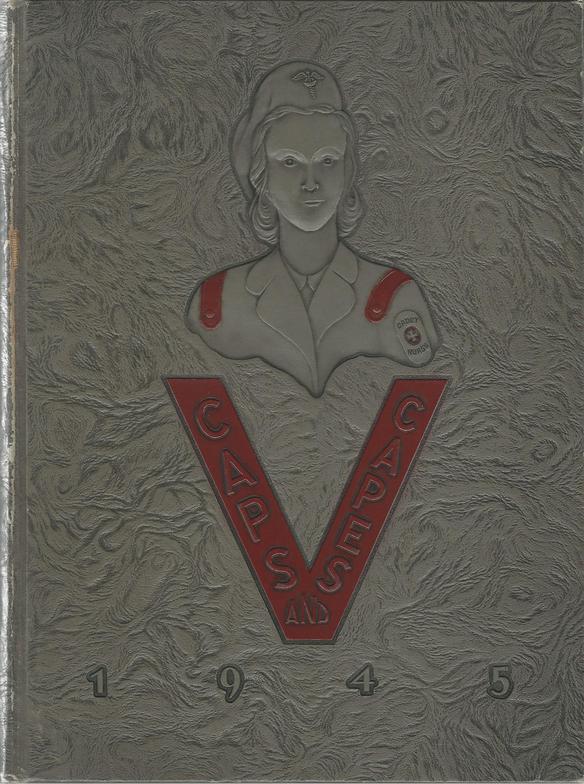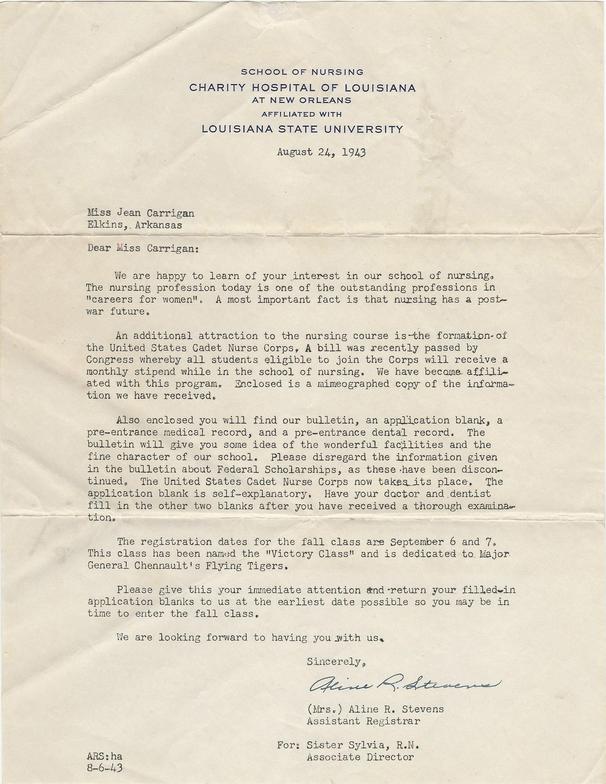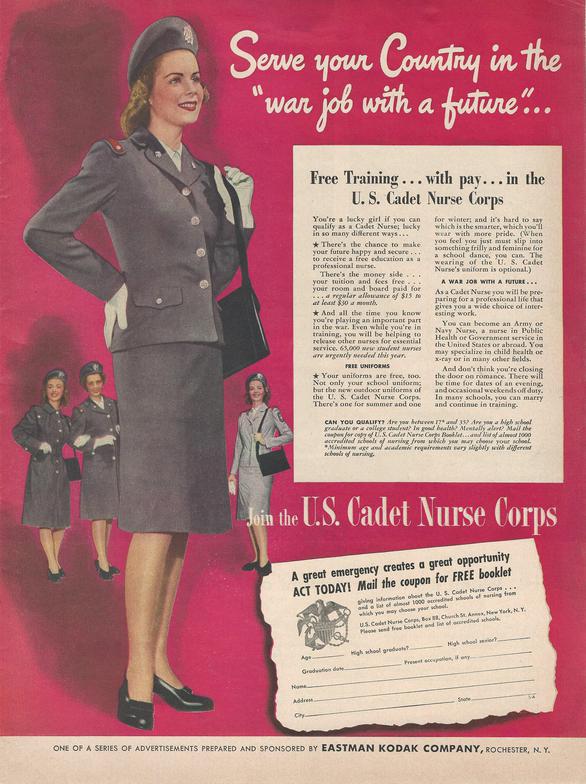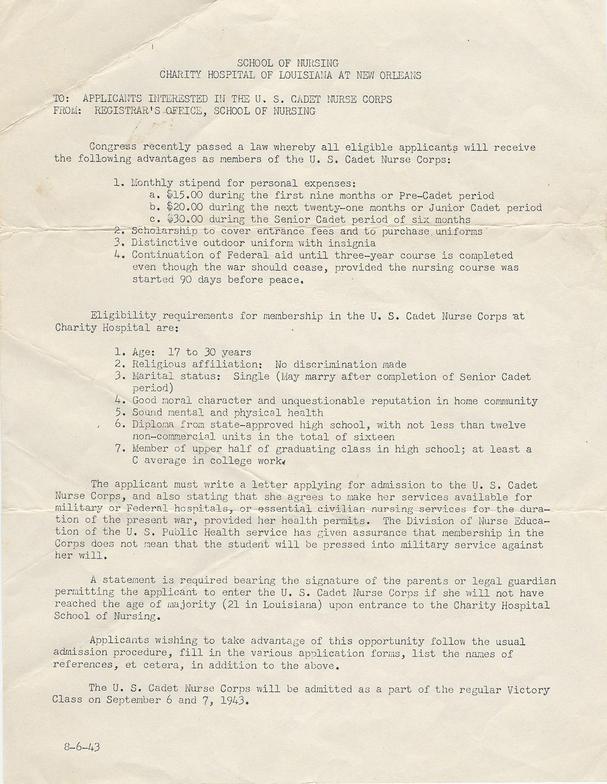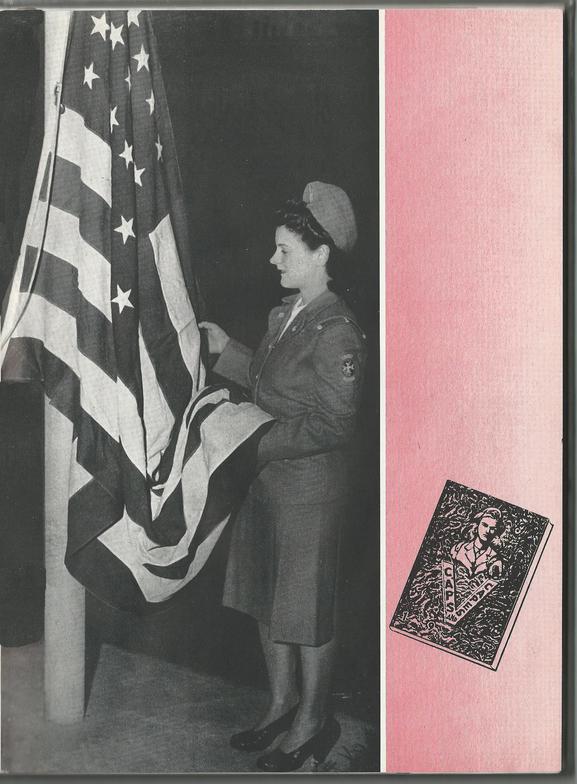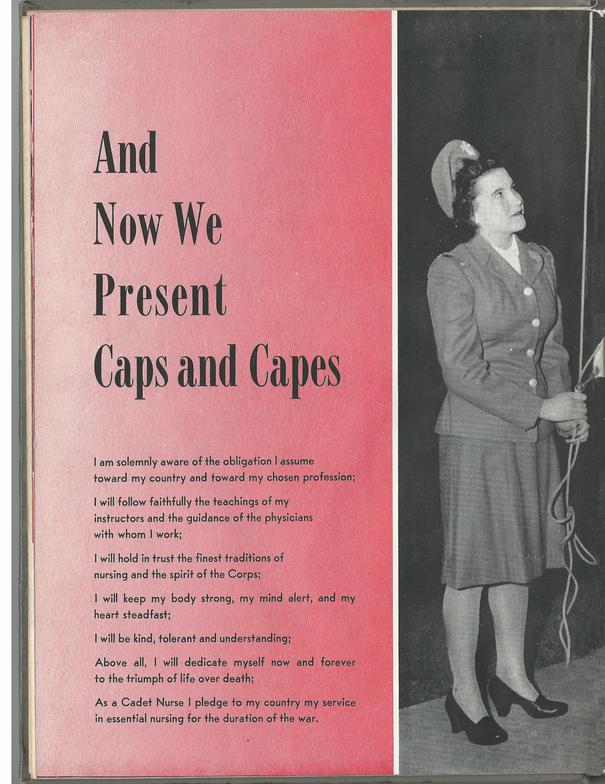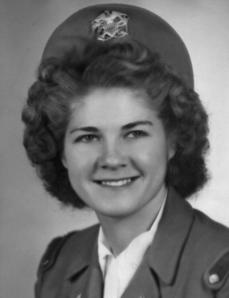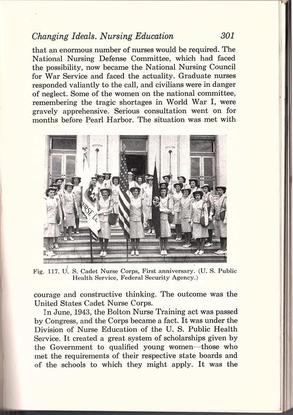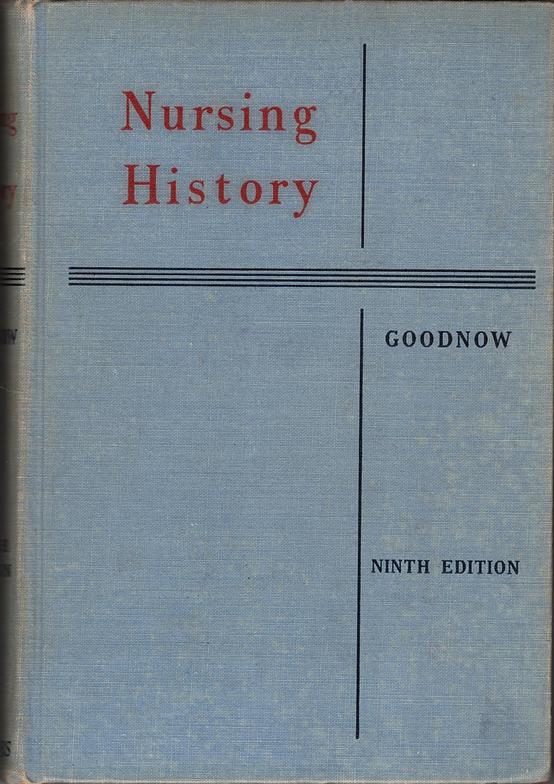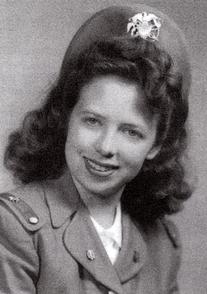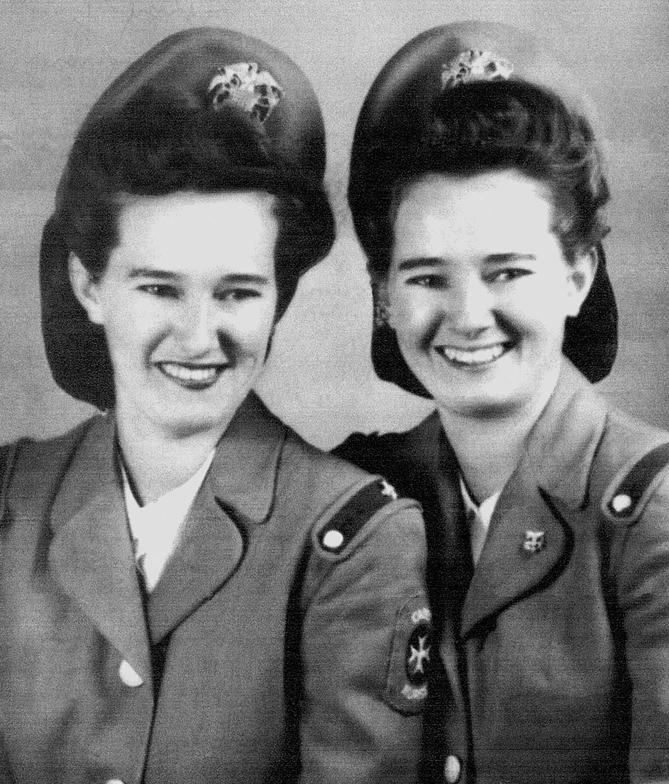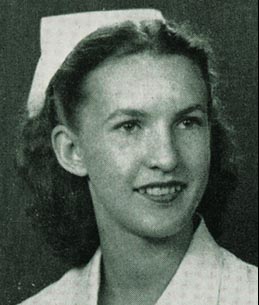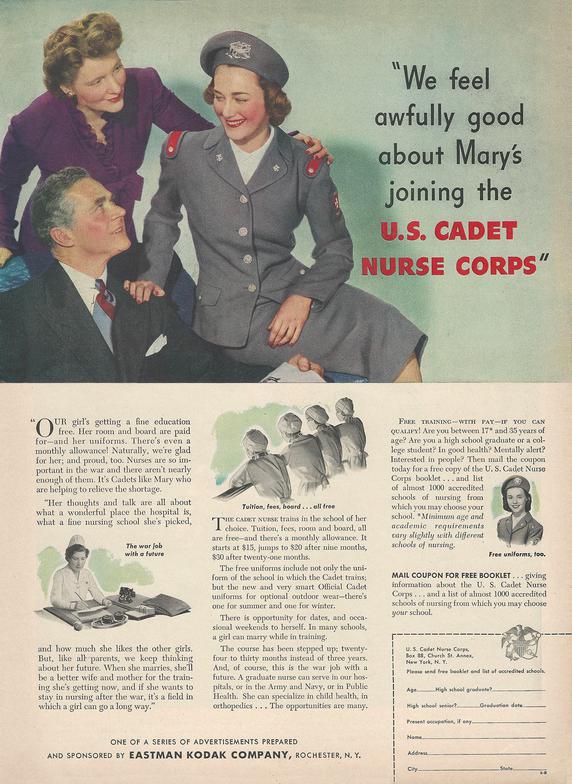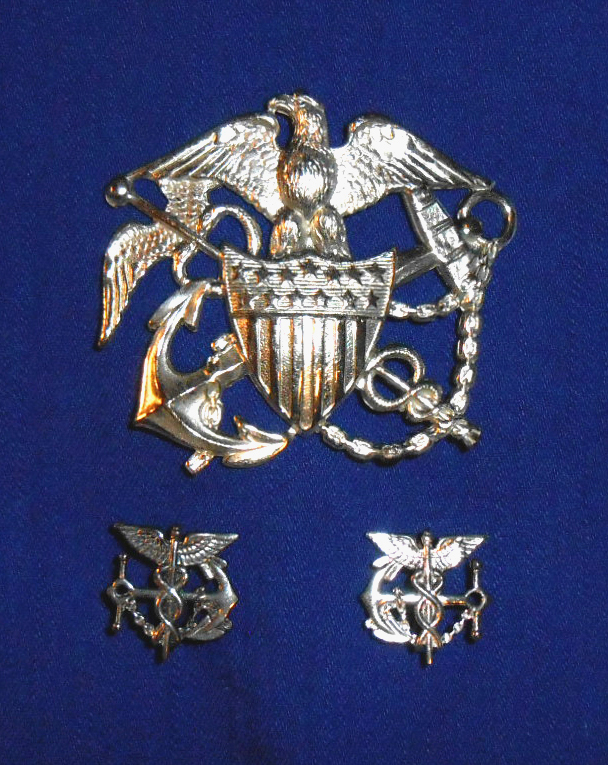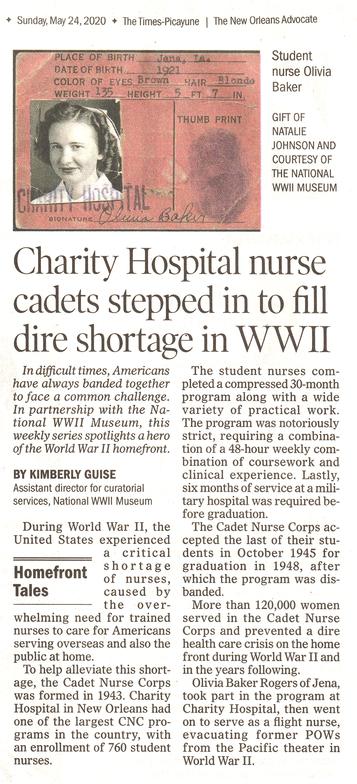Charity Hospital School of Nursing Alumni Association
A Bit of History...
A Short History of the Cadet Nurse Corps
When the United States entered World War II, it was soon clear that a crisis was looming: there would not be enough nurses to serve the needs of both the war front and the citizens at home. In 1943, a bill introduced by Congresswoman Frances P. Bolton established the United States Cadet Nurse Corps to encourage young women to enroll in nursing school and to facilitate their training to meet the burgeoning needs of military and civilian hospitals.
Nursing schools around the country participated, and student nurses who joined the Corps were eligible for a government subsidy for tuition, books and uniforms as well as a small living stipend. In return, Cadets committed to working where they were most needed, in essential civilian, Federal or military hospitals, or in Public or Rural Health Services.
An aggressive publicity campaign was launched, necessary not only to recruit a large number of nursing students, but to allay fears of parents who worried that a nursing career would be drudgery. Numerous companies from Eastman Kodak to Pond’s Cold Cream sponsored advertisements featuring professionally appointed Cadet Nurses and proud parents. These, along with newsreels, articles in prominent women’s magazines, and posters presented the Cadet Nurse as “the Girl with a Future.” A short film, Rewards Unlimited, starring Dorothy McGuire as Cadet Nurse Peggy Adams was featured on movie screens across the country, and actresses made appearances as Cadet Nurses in other films such as Shirley Temple’s Kiss and Tell.
Leading fashion designers were invited to propose their ideas for the Cadet uniform, and a gray and white seersucker suit was chosen for summer, with a gray wool suit for winter. The suit jackets were highlighted with red epaulets and the Cadet Nurses patch. White blouses and a gray Montgomery beret completed the ensemble. The publicity campaign was so successful, the Corps actually surpassed its recruitment goals, and during 1945, 85% of the country’s nursing students were participating in the Corps.
The Cadets were in an accelerated program of study, expected to put in a 48-hour week in a combination of classes and clinical experience. Many nursing schools forbid students to be married while enrolled, and imposed strict rules of behavior and curfews policed by vigilant “dorm mothers.” Cadets often left their homes and families to serve in other parts of the country for the duration of the war.
An amendment to the Bolton Act stipulated that the Corps be a non-discriminatory
program, which led to integration of nursing schools and created unparalleled opportunities for African Americans, Native Americans and Japanese-Americans to become nurses. The Cadet Nurse Corps was responsible for the training of 124,000 nurses, and provided 80% of the nursing staff for civilian hospitals during the war.
When the war in the Pacific came to a close, the Cadet Nurse program was disbanded. October 1945 was the final date for admission to the Corps and the last Cadets graduated in 1948. Although the Corps lasted only five years, its legacy was far-reaching. As a result of the Cadet Nurses Corps nursing education changed dramatically. Schools developed a more academic approach to nursing education rather than the traditional apprentice-style training. Federal funds provided through the Corps built classrooms, dormitories and libraries. Nursing schools were able to increase course offerings to include convalescent care, public health, pediatrics, tuberculosis and psychiatric care. They expanded their faculties and encouraged postgraduate studies. Perhaps most important, the public came to regard nursing as an estimable profession that young women could choose with pride.
Edna Gannon Treuting
Class of 1946
"Our class was the first Cadet Nurse group at Charity. We were admitted in February 1943. Since there was a war going on, two classes per year were admitted. The classes were large, but many students dropped out or were dismissed for various reasons. We wore our Cadet uniforms for special occasions, but our regular white CHSN uniforms for duty on wards.
The majority of students dated servicemen, but we were NOT allowed to be married while we were students. Servicemen were invited to our school dances which were a lot of fun. We were also taken to USO dances. Our dedicated “house mothers” dutifully watched to see that we signed in accurately as we returned at night. One minute or more late, and it was considered a late leave. I don’t remember how many we were allowed, but abuse of late leaves resulted in being restricted to campus or possibly driving the elevator for a period of time.
In order to accommodate two classes into one graduation exercise per year, our February 1943 class’ course work had to be completed to graduate with the September 1942 group, but we were not finished until all our clinical requirements were met and 3 years were up. Therefore we are known as the Class of 1946. Time had to be allowed for the Cadets to serve at a military base depending on the branch of service chosen, but students could be refused leave if the hospital school with a Cadet program was too short of nurses.
One Christmas Eve night, soldiers were allowed to sleep on the sixth floor, in the area used by nursing students as a practice lab for bed-making, etc. I was a Junior on night duty and my floor supervisor told me to take a break and to go to the sixth floor to talk with those poor soldiers. She said they needed someone young to talk to.
Part of our clinical rotation was in the communicable disease unit (a separate building at the rear of the hospital) where we cared for patients with malaria, typhoid, syphilis, etc. A number of these were discharged soldiers.
That’s just the tip of the iceberg of our very strict nursing training during the war, but I loved every minute of it."
After working a number of years at Charity Hospital, Edna Treuting took a break to raise her children, then returned to nursing as a teacher. She earned a Masters of Public Health and Doctorate in Medical Care Administration from Tulane University. She became a professor there, then Dean of Nursing at Our Lady of Holy Cross College, then later the Chief Nurse of the Louisiana Department of Health. She was a trailblazer in the medical field. In 1972, Edna presented a proposal for the Nurse Practitioner Program to the state. Thanks to her research, passion and documentation of the potential benefits, the Nurse Practitioner program was approved. Today she is known as the matriarch of all the Nurse Practitioners in Louisiana.
Cadet Nurse Corps 1943-1948
Opportunities and Adventures
Jean Carrigan
Class of 1947
"I was at Charity from 1944
to 1947. I spent my Senior
Cadet period at DePaul
Sanitarium in New Orleans.
From 1947 to 1984, I worked
at the Veterans Administration
Medical Center in Fayetteville,
Arkansas.
In 1983, after 36 years at the
VA, I was proud to be awarded
the Administrator’s Hands &
Heart Award, given annually to
recognize an outstanding
employee for exceptional, sustained, compassionate, direct patient care. The Cadet Corps and Charity enabled me to accomplish this."
Jean Carrigan retired from the VA after 37 years as operating room supervisor and infection control nurse, but barely slowed down. She volunteered with the American Red Cross, Planned Parenthood, and Washington Regional Medical Center where she spent years as the surgical waiting room volunteer. “She never retired from helping people,” a news article about her said. After moving into a retirement community, Jean organized a volunteer service to help other residents get to their doctor appointments. “Some people just need physical help, but others need me to go with them and write down what the doctor says so they can tell their family later,” said Jean. “I’ve had a lot of practice listening to doctors and asking questions.” Jean died in March 2017, a proud graduate of Charity Hospital School of Nursing.
Betty Mitchell Falterman
and Patsy Mitchell Gordon Sanders
Class of 1946
Betty Joy and Patsy Marie Mitchell were featured in an article in the New Orleans Item when they were born in 1926, as two of “Ten Twins Born in Seven Days in New Orleans.” Seventeen years later, in May 1943, they were featured in another article with their mother, Mrs. Henry Mitchell. Mrs. Mitchell was a former nurse who decided to return to nursing when her husband joined the U.S. Army during World War II. She was taking a refresher course at Charity School of Nursing at the same time her twin daughters were student nurses. Patsy and Betty were pictured showing their mom how to take a blood pressure.
“My twin aunts Betty and Patsy were students at Charity and also in the U.S. Cadet Nurse Corps,” writes Linda Mitchell. “I have another newspaper article entitled Charity Nurse Class of 123 to Graduate. The paper reported that the graduation ceremony at Charity was being held early, in mid-April that semester, because 110 members of the class were Cadets and many would be leaving before the semester ended to complete their senior training at Army hospitals. The students would not actually receive their diplomas until later that fall after they completed their training.
“I have a beautiful picture of my aunts in their Cadet uniforms,” says Linda. “My Aunt Patsy worked at Charity Hospital until she retired. She died of cancer in 1994. Aunt Betty passed in June 2018.”
Gloria Redmond Ashman
Class of 1948
Gloria was born in April 1928 in Panama City, FL. She knew at age fifteen that she wanted to be a nurse and volunteered at a local hospital, learning as much as she could. “But my parents could not afford to send me to college or nursing training,” recalled Gloria. “Then with World War II, there was a shortage of nurses, and the government created the Cadet Nurse Program to encourage more young women to become nurses. The program paid all the tuition and fees, plus room and board, and even a small stipend each month. I applied, was accepted, and was sent to Charity Hospital School of Nursing. This was a wonderful gift to me! It made it possible for me to become a Registered Nurse and to make a living.”
After graduating in 1948, Gloria was commissioned as a Lieutenant in the U.S. Air Force. While serving she met her husband Robert who was also an officer in the Air Force. Over the course of their marriage they traveled the world and had six children. “Bob and I had a great life,” she said. Gloria worked in hospitals around the world. “I have met so many wonderful people and have always been proud of being a Charity Nurse,” said Gloria.
Gloria returned to Panama City and Bob passed away in 1985. She went to work at H&R Block where she recently retired after 35 years. But she always did the continuing education to keep her nursing license current.
Gloria always said that the Cadet Nurse Corps enabled her to become a nurse and she wanted to “pay it forward” by helping current students. She donated thousands of dollars to our Alumni Scholarship Fund over the years, often sending a check for $1,000 out of the blue, with a note and sometimes a photo. “I am not rich and have to save up months to give, but I will continue as long as I can,” Gloria wrote. “I try never to forget all the people who have helped me along the way. It means a lot to me to be able to contribute to the Alumni Association. I feel that this is something that I owe – to help others get their education.”
The Alumni Association established the Gloria Redmond Ashman Scholarship in the Fall of 2014 to recognize her generosity.
“I really enjoy hearing from the students who are scholarship recipients and knowing that the money really helps – I only wish it was a lot more,” she wrote not long ago. Her letter closed with these words: “Best wishes to you all. I won’t ever forget those years. I know you all will keep on helping.” Gloria passed away in June 2018.
Click on the link below to read about new legislative action on the US Cadet Nurse Corps Service Recognition
Marie Gaudet Beaulieu, Class of 46, in her cadet uniform.
